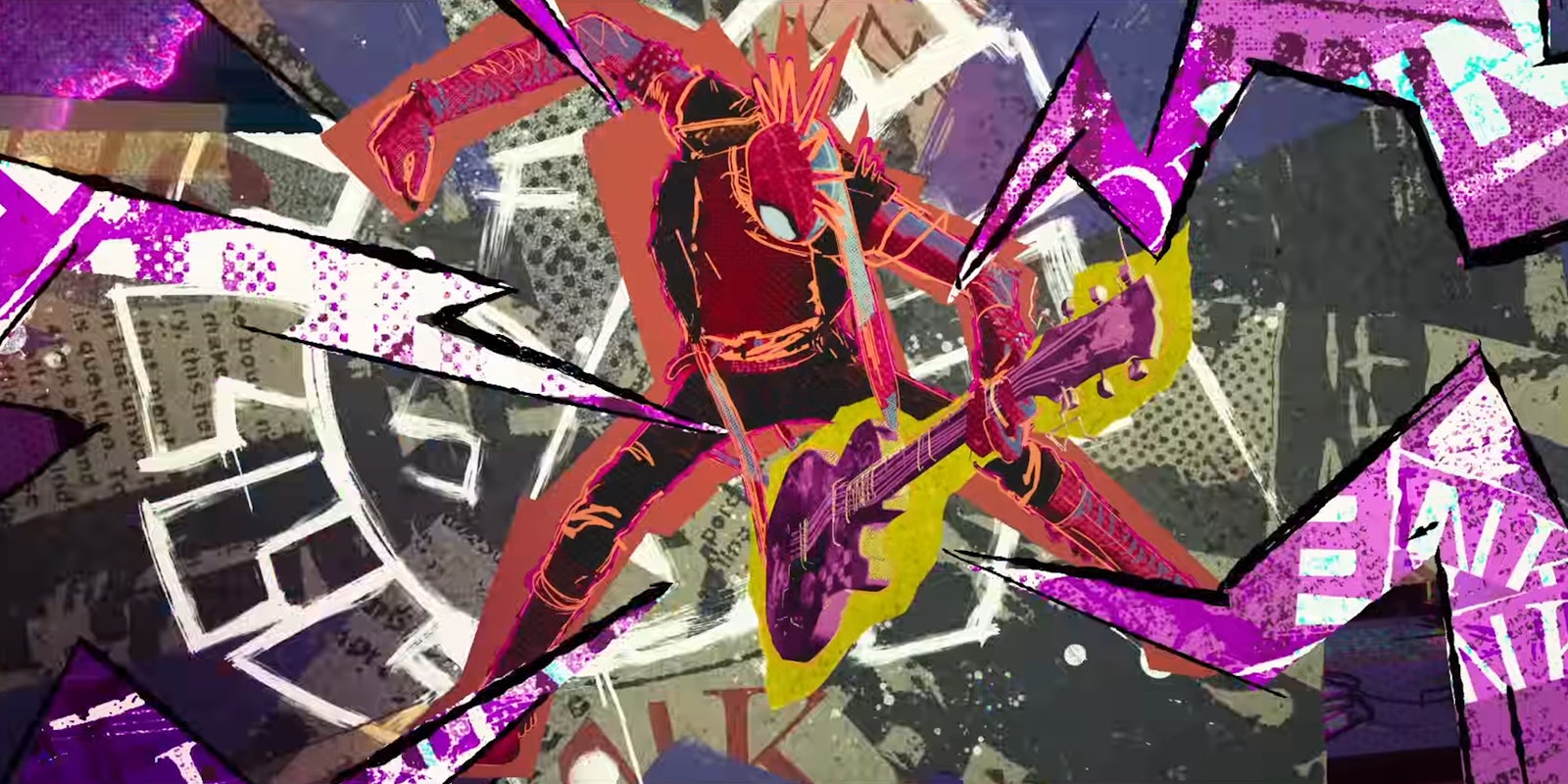Spider-Punk, aka Hobie Brown, is probably the most popular breakout character in Across the Spider-Verse, a punk Spider-Man from a dystopian British timeline.
He’s also one of the most technically complicated elements of the movie, with Spider-Verse animators taking to Twitter to explain the many layers of his creative process. Designed to visually rebel against his surroundings, it took between two to three years to perfect his animation style.
In a film where every Spider-person has a different aesthetic, from Gwen’s “mood ring” pink/blue watercolor palette to Spider-Man 2099’s retrofuturistic Syd Mead universe, Hobie still manages to be the most eye-catching of all.
That’s partly because his character design is so radically stylized, inspired by 1970s punk posters and cut-and-paste zine art. But he also stands out because he’s animated at a different frame rate from everyone else.
How Spider-Punk’s frame rate works
The techniques used for Hobie are a continuation of how the first Spider-Verse movie experimented with frame rates. Using 24 frames per second, hand-drawn films like Disney classics are typically animated “on twos,” meaning one image for every two frames, or 12 images per second. Meanwhile CG-animated films are usually “on ones” (one image per frame), which looks smoother.
Most of Into the Spider-Verse was animated on twos, overlapping with other stylistic choices that reject CG animation norms, paying homage to static comicbook art. Switching between ones and twos varies the speed and impact of a character’s movement, as explained in this New York Times article interviewing Into the Spider-Verse‘s directors:
“Working on one’s and two’s let the artists vary the rhythms of movements. When a scared Miles dashes through a snowy forest, his run is animated on one’s to emphasize his speed. When he stumbles and falls, he rises on two’s as he slowly pushes against gravity to get back on his feet.”
With Hobie/Spider-Punk, Across the Spider-Verse‘s animators experimented with different frame rates to reflect a mobile version of DIY punk visuals, symbolizing the character’s anarchic attitude.
As supervising animator Chelsea Gordon-Ratzlaff explained on Twitter, Hobie was often animated on three’s, but his individual components—guitar, jacket, outline, etc.—were set on different frame rates, giving him a disjointed, disruptive look.
Also, since the textures used for Hobie’s body involve a flickering slideshow of newsprint and posters rather than a block of shaded color, he’s even in motion when he’s standing still. “The textures are random photos from my apartment,” tweeted animator Spencer Wan, referring to his test shot of Hobie, which involved printing out a digital sketch and scribbling on it by hand. “Some of my junk mail is in there.”
“We can assign all these body parts very distinct emotional beats wherever we wanted them to appear like sudden visual changes,” explained co-director Justin K. Thompson in an interview with Discussing Film. “I think that process probably took two or three years to develop, and we really only came together like right at the end.”
In terms of visual worldbuilding, the Spider-Verse movies achieve something that most live-action superhero films barely even attempt: Emulating the visual personality of comicbook art.
For instance while some MCU movies include references to iconic Marvel illustrations (Black Panther‘s Wakandan production design; Thor: Ragnarok‘s Jack Kirby influences), they still share a “realistic” aesthetic with little in the way of stylized framing, choreography, or color choices. (Tim Burton’s Batman films are a rare example that actually do echo the stylized nature of the comics, combining gothic theatricality with 1940s noir and German Expressionist shadows.)
Spider-Verse‘s varied animation styles reflect the worldbuilding and tone of each individual character and universe. And while Miles’ world is relatively straightforward, side characters like Spider-Man Noir and Hobie Brown get more leeway to be weird.
Along with being a Sex Pistols-era punk homage, Hobie’s abrasive, DIY-aesthetic ties into his role in Miles’ story, eventually helping Miles escape the technocratic faux-utopia of the Spider-Society, and reject Spider-Man 2099’s rigidly authoritarian enforcement of “canon.”



